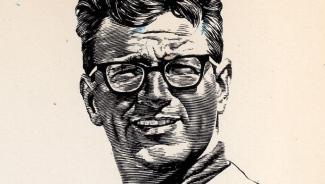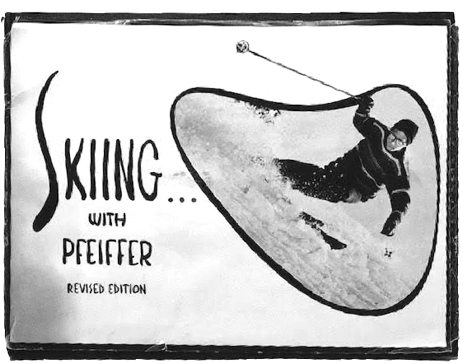Classics: Revolution in Ski Teaching

Reprinted from the November 1971 issue of Skiing magazine.
The Crisis in Ski Teaching—A Revolution Is Needed: Ski Instruction Is All Wrong
If All the World’s Ski Instructors Suddenly Disappeared, Would Anyone Really Miss Them? Would Anyone Care?
Up until a year ago, any of the above lines might have been an apt title to this article. Oh, sure, there were good individual instructors here and there, in this country and abroad. But organized instruction the world over was hung up on the Final Form Syndrome: Your hands had to be here, your pole planted there, you had to do this with the downhill shoulder, do that with the hip and observe a half-dozen other bits of body position dogma.
But now, new-think has hit the slopes. The youngbloods have triumphed. We’ve got short skis. And still shorter skis. And all kinds of Graduated Length Methods. And we’ve got avalement and jet christies and sit-back techniques and anticipation and square stance. And new designs in equipment. And instructors trying out this new equipment, actually trying to ski these new ways. And they don’t have to go over to the backside of the mountain where the fuddy-duddy ski school director won’t see them. They’ve been demonstrating these new techniques to one another at their official symposia and clinics, both here and in Europe. At last, there’s hope.
Unfortunately, the adoption of the signs of progress does not necessarily mean victory for the substance of progress. A case in point: GLM, the much-vaunted system (justifiably, in our view) of learning to ski with short skis and progressing to longer ones. This season, in the USA alone, more than 100 schools will be teaching some version of GLM. There’s Clif Taylor’s method of some 10 years standing: Lock the feet together, then swivel the feet or the legs or the knees or the hips or the whole body, depending on the kind of turn you want. A legs-glued-together, pivot-under-foot turn, turn, turn technique. And you’ve got the Karl Pfeiffer, ex-Killington Ski School GLM, now Headway system. Wide stance, independent leg action, some reliance on snowplow-stem progression. Both these systems start you out on three-footers, let you putter around fruitfully for a day or so, then move you up to four-footers. You move to longer skis only as you develop strength to handle more lumber.

Then there’s the Vail approach—standard teaching on five-footers. And the Aspen-Breckenridge-Sun Valley approach—standard on four-and-a-half footers. Or Paul Valar’s four- and five-footers. And so on.
Which makes one wonder. Hans Thorner (Magic Mountain, Vt.) was quoted as saying he was going to GLM because “you’ve got to give customers what they want. You can’t buck a trend.” But what is the trend? Simply to use shorter skis? That’s a good thing in itself, of course. Anything shorter than the skis a racer or instructor uses is an improvement. For years, there have been men around like Professor Frank Salymosi who have done studies to show how much stronger the twisting muscles of even a girl ski teacher’s legs are than those of a football player or weightlifter. Why anyone should expect the sedentary layman just taking up the sport to have the muscle power to twist those long appendages is a mystery; but at least those days are over.
But GLM should be more than simply chopping a few feet off the long boards. Put on three-footers an intermediate skier who can’t shake his stem, and with the proper remedial exercises, he’ll learn how to turn them both at the same time. But if instead of the proper remedial exercises, he gets more of the down-up-down, drop your shoulder, hold your hands here, put your pole there final form nonsense, the short skis won’t help a bit. Similarly, the beginning GLM student may find himself in just another New American Official National Modern System Technique.
The crux of what’s been wrong with ski teaching is that by and large there have been too few teachers (T-E-A-C-H-E-R-S, that is) involved with the sport. Instruction has been dominated by ex-racers, ex-coaches, ski businessmen—good skiers all. Often conscientious would-be teachers. But all too few have made any study of how people learn. It may not be necessary for them to have read Pavlov and Watson and be familiar with terms like conditioned reflex and gestalt (though it wouldn’t hurt!) to be effective teachers. But a syllabus, a recommended learning progression that doesn’t take into consideration such things as the conditions most conducive for a transfer of training, the moment of readiness, the need to learn at one’s own pace—individual differences, in a phrase—or the effect of motivation on the rate of learning, such a syllabus is doomed to failure. The emphasis in ski instruction has been on technique. And on maneuvers. Instruction is still hung up on some of the paper logic laid down by Hannes Schneider, the famous Father of Ski Teaching, who developed the original ski technique—The Arlberg Technique—some 50-60 years ago. That logic held that first you learned the snowplow, then the snowplow turn, then the stem turn, then the stem christie and finally (but only after 30 years of development had taken place did he begin to concede you could learn) the parallel christie. Neat. Ordered. Logical.
And all cockeyed. A progression of maneuvers would make sense only if one could demonstrate a transfer of skills from one maneuver to another. As generations of skiers have learned, the snowplow is so totally different from the parallel christie, it is a devil of a job to unlearn it. Yet, teaching skiing has become synonymous to many teachers with forcing people into the maneuver mold. Instead, I submit, learning to ski is in large measure a matter of developing specific muscles for basic skills. Yet, where do you even find these basic skills defined? Skills like edge control. Or weight control—being able to move your weight forward or backward or from side to side, as needed. Skills like ski and foot manipulation, which come from just plain walking around with your skis on. The skills needed for balance.
If these skills are not even defined by the instructors, it’s small wonder there has been scant research to see which ones are involved in skiing, how much they need to be developed, how they can be developed. Admittedly, many a fine ski instructor has an intuitive grasp of what’s involved. He may go through the maneuver-teaching sequence, but in the process he manages to get the skills across to his charges. But it’s almost accidental, for the emphasis on final forms focuses the teacher’s attention—and therefore the student’s attention—on the wrong things. After all, if a person can control his edges, can balance himself fore and aft and side to side, then the maneuvers of skiing become simple.
Now that ski schools are finally abandoning so many of the old absolutes (weight doesn’t have to be on the downhill ski, weight doesn’t have to be on the fronts of the skis, shoulders don’t have to be facing down the valley, etc.) there is hope. Take a look at the instructors at your area. Are they still skiing automaton style, locked into a rigid Wedeln? Or have they turned loose, making those wild, smooth, sinewy turns that characterize today’s hot shots? If they’ve come out of hiding, by all means, go take a lesson. Then odds are in your favor that you’ll learn more this year—at any level—than you would have last season. Enough so, perhaps, that you may want to become a ski instructor yourself.
A founder of PSIA, freestyle skiing pioneer and influential magazine editor, Doug Pfeiffer recently died at 96 after a distinguished career. See obituary. 
